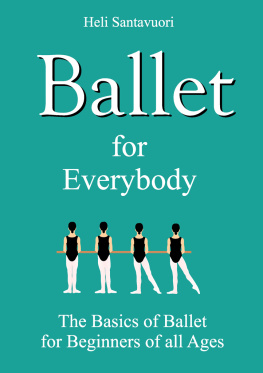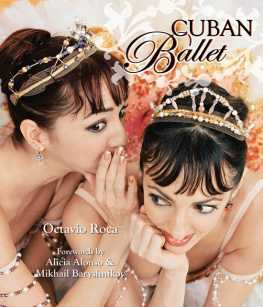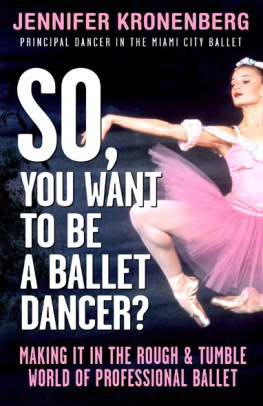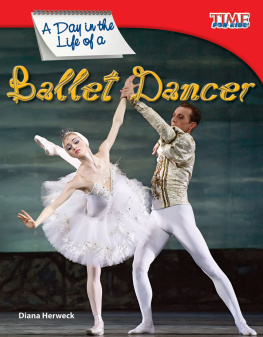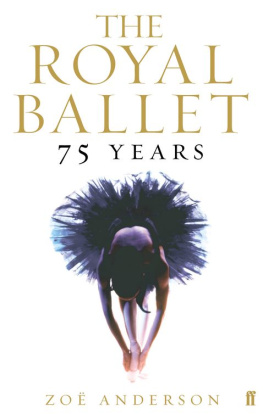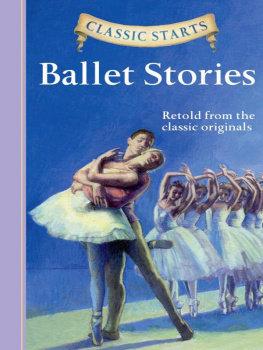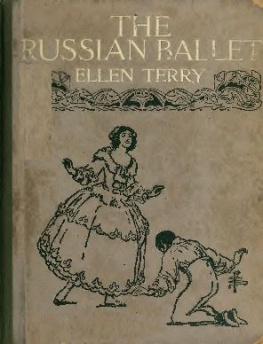Copyright Heli Santavuori 2017
Publisher: BoD Books on Demand GmbH, Helsinki, Finland
Printed by: BoD Books on Demand GmbH, Norderstedt, Germany
ISBN 978-951-568-613-8
Index
Welcome to the World of Ballet!
The Finnish edition of this book has been very well received.
One reader wrote to me that she had begun studying ballet at the age of 75. That was four years ago. One room in her home was now a studio, she wrote, and as training help she had my book! Her letter really made me happy.
When I was young and training hard, I always thought that everybody should learn ballet, it gives you so much joy and physical selfknowledge.
The basic technique of ballet is of a great use to many. Even the stars in Soviet Unions ice hockey team learned from ballet technique in order to become better ice hockey players.
Ballet technique gives strength and mobility in a balanced way. Your posture will improve. You will also find deep satisfaction in the emotional and artistical side of the training.
The popularity of adult ballet is, in my mind, a back to basics thing in a time when different dance styles are abundant. To master different styles has one precondition: to master the basics. There is no better way to achieve this than studying ballet.
Heli Santavuori
May 4th 2017 in Helsinki, Finland
Index
(For a more detailed index, se page )
It is a Good Idea to Practice at Home
Especially,
- if you dream of taking ballet classes but hesitate for some reason. You will learn what kind of exercises a ballet class consists of. You can experiment in practice and find out if this is your thing.
- if you have been dancing ballet in your youth. This book is a memory help especially when some of the rules are a bit difficult and therefore easy to forget.
- if you practice ice skating, gymnastics, aerobic, or any other training form and want to make progress.
- if you are already taking ballet classes. Then it is a good idea to go back to basics from time to time. You have now the possibility to concentrate on things that are especially difficult for just you.
- if you only have the possibility to take classes only once or twice a week, and want more.
- if you study some other dance form (or forms) and dont have the possibility to take ballet classes as well.
- if you are a beginner and perhaps not so fit. The basic barre exercises are good for everybody, just follow the instructions carefully. Additional pilates exercises can help you to understand the basic posture, if there is a problem. Stretching is also recommended; better mobility is always an advantage.
General Instructions
At home, you can train with socks on, if the floor is not too slippery. Gymnastics or jogging shoes are not good for ballet.
If you decide to go on with ballet training, the first thing to buy is a pair of soft ballet slippers. They are made of cloth or leather. Bend the heel of the slipper as in the picture: this shows the place where you must sew a rubber band.
Silk ribbons round the ankle are for pointes ballet shoes, they are not necessary with soft slippers. (Dancing on point is a thing that requires a live instructor and a few years of ballet studies. It is not something you can learn from a book at home.)
Next, you need a barre. A steady couch or arm chair is fine. Sport shops also sell different kinds of barres for ballet, for push ups or chin-ups.
Anyway, you should not lean on the barre or couch with all your weight your hand on the barre should be light, relaxed. Preferably, you should hold the fingers, the thumb included, on top of the barre.
A mirror helps a lot, at least occasionally.
Your hair should be tied so that it is out of the way. Otherwise it is not so important what you are wearing. But you should keep yourself warm in the beginning of the training session. And of course, tights and leotards are good when testing postures in front of a mirror.
Music is an essential part of ballet training. I recommend .)
The Basic Posture
A dancer must maintain the correct posture through the entire performance, otherwise the whole movement collapses. The strength required in this upward striving posture comes from the muscles in the belly, buttocks and back.
A good, upward striving posture makes it possible for the upper body, neck and head to move freely without any sign of muscle strain, and for the arms to move smoothly and effortlessly from the shoulder blades.
Birgitta Kiviniemi-Cheremeteff
A former principal ballerina in the Finnish National Ballet and a ballet teacher
In the following, the basic posture is described in a somewhat pedantic manner.
You should not underrate these rules. Only when your posture from the tip of the toes to the fingertips is controlled and becomes a conscious habit, you will have an almost meditative experience from your ballet training. It is not gymnastics anymore, but a comprehensive practice of body and mind. This makes you relaxed, refreshed, and gives you profound satisfaction.
Remember that all barre workout is, at the same time, exercise in learning the basic posture. Your posture, balance, and control of your body improve if you do these exercises in a conscious way and only then.
Basic Posture on the Floor
In this position, it is easier to concentrate on essential things: pulling the belly button inward and finding the neutral position of the lower spine this means maintaining the natural curve of the spine. Your buttocks are not in the way, you need not worry about the balance and your joints are at rest. To find and activate the muscles of your lower stomach is the foundation of a good posture.
All movement starts in the center. This is also true in classical ballet, even if it looks like only your legs and arms are moving.
Imagine that you have divided your body in two parts: (1) The lower stomach muscles, (2) everything else.
(1) Pull your belly button inward. Feel how your lower spine straightens it does not, however, attach itself completely to the floor. The natural curve in your lower spine must remain.
Pull your belly button inward especially at the end of expiration. Breathe evenly and naturally. You are NOT supposed to breathe as deeply or as slowly as possible.
(2) As you breathe, try to relax all other parts of your body: toes, calves, thighs, hip flexors, hip joints, diaphragm, rib cage, shoulders, neck, arms, hands, and face.
This was the first and the most basic isolation exercise: while one part of the body is at work, the other parts are relaxed, although in a controlled way. In classical ballet technique, this generally means that the lower body is at work while the ribcage, neck, head, and arms are relaxed and smooth. It also means that your hips should not move when the legs are moving, and hand movements dont cause the torso to rotate.
Basic Posture 2 Standing in Parallel
The center line of balance
A straight standing position is a slight, very small forward tilt. The center line of balance, however, is 90-degree from the ground, that is, the line between the two black points in the illustration.
Next page
